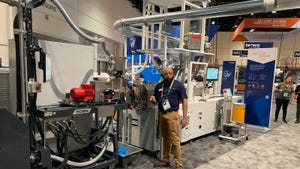Active Food Packaging That’s Renewable and Recyclable
European REFUCOAT Project develops recyclable bioplastic food packaging coating systems that protect against Salmonella.

Food waste has become a worldwide problem. According to the Food and Agriculture Organization (FAO), each European Union citizen on average throws away 179 kilos/395 pounds of usable food per year. Food loss and wastage must be reduced to create a Zero Hunger world and meet the Sustainable Development Goals (SDGs), particularly SDG 2 for zero hunger and SDG 12 for responsible consumption and production.
Plastics are the most common packaging technologies that extend the shelf life of food due to their unique versatility, lightness, ease of handling and strength. Despite all these advantages, the European Union’s 2018 plastics strategy determined that all packaging must be recyclable by 2030. Meanwhile, consumers’ increased environmental awareness has made it necessary to continue with research to obtain more sustainable packaging.
Within this context, the European REFUCOAT Project developed sustainable active packaging solutions to address the challenge set by the European Union for 2030 by doing research on packaging solutions that could positively impact the reduction of food waste. Specifically, innovative and efficient bioplastic production processes were developed to package food using renewable materials that are also recyclable and could replace conventional fossil-fuel-based materials. Announced December 29, these bioplastics include polyhydroxyalkanoate (PHA) and polyglycolide (PGA), which were used to develop three different bio-based active packaging systems engineered to package fresh chicken meat, cereals and snacks.
Active coatings.
Additionally, one of project’s greatest innovations was the formulation of bacteriophage-based coatings that considerably reduce the proliferation of Salmonella bacteria in chicken breast samples packaged in a modified atmosphere. The project successfully addressed one of the problems faced by packaging with barrier properties: in order to protect food, packaging must be made up of complex multilayer structures that are either difficult or costly to recycle. However, all the packaging systems developed by the REFUCOAT Project can be recycled and/or converted into compost, which makes them a very promising sustainable alternative to current packaging on the market.
Lorena Rodríguez Garrido, a Packaging Researcher at AIMPLAS, the Plastics Technology Centre, and the scientific coordinator of Refucoat, says, “Packaging must be recyclable and must also maintain the barrier properties that help protect packaged food. Current packaging has a complex multilayer structure and is made from non-renewable sources. It provides all the protective functions but is difficult and expensive to recycle. REFUCOAT aims to replace current packaging with more sustainable, better-performing alternatives.”
High-performance packaging.
In three years, the Refucoat Project focused on three main areas: developing active coatings for food packaging films that use bacteriophage organisms to extend the shelf life of food products and provide a significant reduction in the proliferation of Salmonella in chicken breast samples packaged in a modified environment; using low-quality flour — a food industry by-product that would otherwise be wasted — as a base to produce PHA, which is then used to manufacture food trays that extend the shelf life of fresh chicken meat products; and, finally, developing an efficient production process for PGA, a completely biodegradable material with excellent water barrier properties, which gives it promising applications for food packaging. Until recently, this solution had been too expensive to use to replace fossil-fuel-based materials.
The Refucoat Project ended in October 2020 after successfully validating all the new packaging structures and comparing their performance with metallized packaging for non-biological applications currently used for industrial products. Tests were also carried out to compare the products’ shelf life and biodegradability with those of current conventional packaging on the market.
About the Author(s)
You May Also Like

